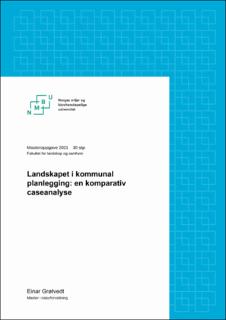| dc.contributor.advisor | Bergaust, Tore Edvard | |
| dc.contributor.advisor | Aude, Anne | |
| dc.contributor.author | Grøtvedt, Einar | |
| dc.coverage.spatial | Norway | en_US |
| dc.date.accessioned | 2021-12-07T14:22:50Z | |
| dc.date.available | 2021-12-07T14:22:50Z | |
| dc.date.issued | 2021 | |
| dc.identifier.uri | https://hdl.handle.net/11250/2833195 | |
| dc.description.abstract | Denne oppgaven søker å besvare i hvilken grad hensyn til landskapet blir vurdert og vektlagt av den kommunale planleggingen, og hvorvidt dette blir gjort i tråd med Plan- og bygningslovens rettslige plikter som berører dette temaet. For å undersøke dette tas det utgangspunkt i tre caser i form av reguleringsplanprosesser for utbyggingsprosjekter som har vært gjenstand for offentlig kritikk, med henblikk på å teste lovens rammer for ivaretakelse av landskapet. Casene er Sætre Havn på Hurumlandet, Flisvika i Risør og Mjøstårnet i Brumunddal.
Bakgrunnen for oppgaven er todelt. Etter Norges ratifisering av den europeiske landskapskonvensjonen i 2004, forpliktet landet seg til å etterfølge en rekke mål og tiltak for å styrke landskapets posisjon i norsk planlegging. Et resultat av dette er at landskapet ble viet en større synlighet i dagens gjeldende Plan- og bygningslov fra 2008. Landskapet er også et tema som er gjenstand for konflikt. Ved nye utbyggingsprosjekter oppstår det ofte debatter der lokale innbyggere protesterer mot utbygginger de ikke synes passer inn i landskapet. Disse debattene har den siste tiden tilspisset seg og blitt viet større oppmerksomhet på nasjonalt nivå etter Arkitekturopprørets store oppslutning og medieomtale.
Landskapstematikken berører flere aspekter ved planleggingen, hvilket reflekteres i det empiriske materialet som blir lagt til grunn. Funnene i oppgaven peker på tendenser både ved loven i seg selv og ved planlegging etter loven. Lovens bestemmelser som berører landskapshensyn er løst definerte og gir forvaltningen et relativt stort tolkningsrom. Av tendenser ved planleggingen trekker oppgaven frem at forvaltningens vurderinger av landskapet blir dårlig kommunisert, og at det i liten grad tilrettelegges for medvirkning som gir lokale anledning til å påvirke fremtidig utforming av landskapet slik de selv ønsker. I tillegg kan det fremstå som at vurderingen om bortfall av plikten til å foreta konsekvensutredninger blir feilaktig praktisert i henhold til bestemmelser i forskrift. | en_US |
| dc.description.abstract | This thesis aims to ascertain to what degree the consideration of "the landscape" is considered and emphasized within municipal planning, and if this is being done in accordance with the legal duties of the Planning and Building Act. This will be done by examining three zoning plan processes for development projects that have been subject to public criticism, in order to test the legal framework for sustaining the landscape. These will make up the cases of the study. The cases are Sætre Havn in Hurumlandet, Flisvika in Risør and Mjøstårnet in Brumunddal.
The relevance of the thesis can be traced to two incidents. After Norway ratified the European landscape convention in 2004, the country committed to comply with a set of goals and measures in order to enhance the landscape's importance in Norwegian planning. This resulted in the landscape being more prominent in the Planning and Building Act of 2008. The landscape is also a topic of disagreement. There are often times public debates in relation to new development projects, where locals protest against building projects which they deem out of place in relation to the landscape. These debates have in recent times gained support on a national level after the large support and media coverage of the group "Architectural Uprising" (Arkitekturopprøret).
There are several aspects of planning that affect the landscape, which is reflected in the empirical data being presented in this thesis. The findings of the thesis point out tendencies both in regards to the act itself, and to the practical aspects of planning in accordance with the act. The sections of the act that affect the landscape are imprecise and provide the municipal administration a relatively large room for interpretation. Regarding tendencies with planning, the thesis calls attention to the fact that the municipal administration's assessments of the landscape are poorly communicated, and that there is a small degree of facilitation for public participation, from where locals are given the opportunity to influence future shaping of the landscape the way they desire. In addition, it appears that the exception from the duty to conduct an impact assessment is being wrongfully practiced according to regulations on impact assessment. | en_US |
| dc.language.iso | nob | en_US |
| dc.publisher | Norwegian University of Life Sciences, Ås | en_US |
| dc.rights | Attribution-NonCommercial-NoDerivatives 4.0 Internasjonal | * |
| dc.rights.uri | http://creativecommons.org/licenses/by-nc-nd/4.0/deed.no | * |
| dc.title | Landskapet i kommunal planlegging : en komparativ caseanalyse | en_US |
| dc.type | Master thesis | en_US |
| dc.description.localcode | M-NF | en_US |

